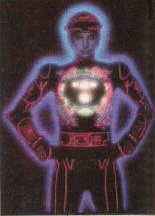
Englewood, N.J.,
teen-agers play video hockey game on an enlarged TV
screen
The coin eaters
are more challenging, but the home sets black out General
Hospital
| the blood is not real and
that the games are harmless fantasy. (Though it
is hard to deny that some of the fantasies are
fairly creepy. As Producer Frank Marshall admits,
when you lose your last city—there goes
Cleveland—in Missile Command, "it's
depressing.") The sunny and cheerful exception to the prevalent theme of electronic Gotterdammerung, and one of the few games so far that women play in large numbers, is Bally's Pac Man. Pop psychologizers note that it is not a game of shooting, but—aha!—engulfing. It may also be the ultimate eating disorder; the player directs a happy-looking yellow disc around a maze, as it gobbles cookie-shaped dots, and tries to avoid some not-very-menacing monsters. It is by no means easy to play, though some men feel it is unworthy of serious attention because it has only one hand control. Linda Starkweather, 29, who runs a beauty salon in Union Park, Fla., got hooked on a Pac Man she discovered near by at Jake's Ice Cream Shop. So did her two women employees. Then they found another Pac Man at a neighborhood sandwich shop and began straggling back late from lunch hour. When Starkweather found herself struggling to limit herself at each session to $3 or $4, the obvious next step was to install a Pac Man in her shop. "We've spent all our tips already this morning," she said-not long ago, laughing. Ann Williams, one of her former operators and now a Tupperware saleswoman, calls herself a "closet Pacperson." She admits to spending $15 on one session, and although for a while she didn't tell her husband, she feels no guilt: "It's my money; I earned it. There's not a lot of fun things in life. It's taken away my boredom. I've never been as serious about anything as Pac Man." |
Serious? Listen to Los
Angeles Screenwriter Jeffrey Alan Fiskin, who
discovered Pac Man earlier this year during the
Hollywood writers' strike: "Oh, pipe down,
all you fans of Asteroids and Defenders," he
wrote in California magazine. "Take your
arrested adolescence elsewhere!…We want
philosophical rigor, a metaphor for life
…" The task of Pac Man, Fiskin notes
solemnly, is to clear a labyrinth, and as he
succeeds, he collects point-scoring rewards, all
very symbolic: first food in the form of fruit,
then keys—"the key to wisdom, the key
to the next level; ah, the pure Jungian
simplicity of it." Fiskin warns that
"you will' pay and pay to learn the
intricacies of this labyrinth, these demons. The
parallel to psychoanalysis has, perhaps, not
escaped you..." Like many of the best games, Pac Man is a Japanese design, and so far Bally's Midway division, the U.S. licensee, has produced 96,600 of the machines here (Asteroids is second, at 70,000; and third, at 60,000, is Space Invaders, the game that began the video craze three years ago). Counterfeit machines sell briskly, much to the displeasure of Bally's lawyers, who are kept busy fighting copyright infringements. Forging a Pac Man or Centipede game is not much more complicated than pirating a music cassette or videotape. A modern game may require six $20 ROM 32-K chips, each of which handles 32,000 bits of information. ROM means "read only memory," and refers to a permanently programmed chip, not one that can "learn" and "forget" information. Joel Gilgoff, owner of a four-store arcade games supply chain called G.A.M.E.S., in Van Nuys, Calif., says, "That amount of memory rented for $50,000 a month six years ago." The waves of color, shape and sound that crash about the ears of the bedazzled |
A desk-top machine called an EPROM programmer (for Erasable Programmable Read Only Memory) can steal the information on a programmed chip and transfer it to a blank chip in about one minute. EPROM units cost about $2,500, which is a great improvement over the $1 million or more it takes to develop a successful new game (see box). Thus it is not hard for a counterfeiter to offer immediate delivery and a price several hundred dollars lower than list.
Ten minutes ago, let's say, Pac Man pirates—yo, ho, ho and a chip of ROM--did not exist. Now they are only one of the dangers in a fast-shifting market in which hot-shot operators whisper into the ears of kindly and greedy old candy-store proprietors that the right game in a good location can bring in $400 a week, or more than a strong man can earn selling used cars. Put in one and you've got a used-car salesman. Take ten and you have a tame orthodontist on a leash. A few store and arcade owners buy their own game machines, counterfeit or not, but most give floor space to machines owned by distributors who farm out and service hundreds of them. Store owners and distributors generally split the take equally. In either
|


